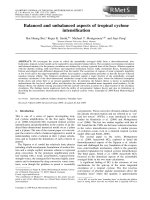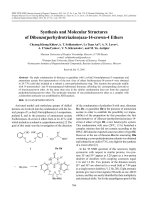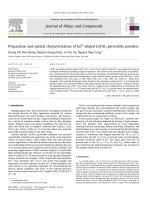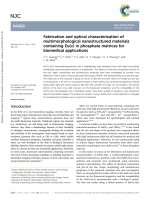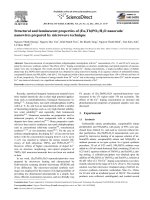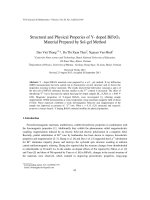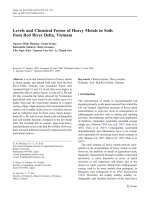DSpace at VNU: Fabrication and optical characterization of multimorphological nanostructured materials containing Eu(III) in phosphate matrices for biomedical applications
Bạn đang xem bản rút gọn của tài liệu. Xem và tải ngay bản đầy đủ của tài liệu tại đây (2.48 MB, 6 trang )
NJC
View Article Online
Published on 09 January 2014. Downloaded by University of Massachusetts - Amherst on 26/10/2014 06:27:40.
PAPER
Cite this: New J. Chem., 2014,
38, 2114
View Journal | View Issue
Fabrication and optical characterization of
multimorphological nanostructured materials
containing Eu(III) in phosphate matrices for
biomedical applications
T. T. Huong,*a L.T. Vinh,ab T. K. Anh,a H. T. Khuyen,a H. T. Phuongac and
L. Q. Minhad
EuPO4ÁH2O nanorods/nanoparticles with a rhabdophane-type hexagonal form have been successfully
synthesized using microwave assisted co-precipitation. The effects of chemical composition and pH on
the size, shape, morphology and luminescence properties have been investigated by powder X-ray
diffraction, Field Emission Scanning Electron Microscopy (FESEM), and photoluminescence spectroscopy.
The mean size of the nanorods is about 15–30 nm in diameter and 200–400 nm in length and the size
Received (in Victoria, Australia)
7th October 2013,
Accepted 9th January 2014
DOI: 10.1039/c3nj01206a
of nanoparticles is 10–20 nm. A powdered sample of these EuPO4ÁH2O nanorods/nanoparticles emitted
yellow-green light with narrow bands at 594, 619, 652, and 697 nm under UV-vis excitation. The surface
effects of the built core–shell structure on the fluorescent properties, and the compatibility of the
EuPO4ÁH2O nanomaterials with a biological system, have been studied to develop a new fluorescent
label for biomedical imaging. The primary test results in using a EuPO4ÁH2O–Immunoglobulin G conjugate
for recognizing the measles virus in a vaccine is presented.
www.rsc.org/njc
Introduction
In the field of in vivo biomedical imaging, recently, there are
three main types of luminescent materials used in labelling and
imaging:1–3 organic dyes, semiconductor quantum dots, and
rare-earth fluorescent materials. Traditional organic dye materials
(e.g. rhodamine), are still being used in fluorescence imaging,
however, they show a disadvantage because of their instability
in biological environments, consequently limiting the sensitivity
and selectivity of the investigation. Nano-crystals based on semiconductor quantum dots such as CdS or CdSe, which exhibit
excellent fluorescent properties, durability and good solubility in
water, are well developed in the field of biological fluorescent
labelling. However, these materials in practice exhibit high toxicity,
which is a barrier for their use in potential applications. Therefore,
in recent years, fluorescent nano-materials containing rare-earth
ions have become promising candidates as labelling materials in
biomedical imaging techniques because of their non-toxicity and
strong luminescence properties.4–7
a
Institute of Materials Science, Vietnam Academy of Science and Technology,
18 Hoang Quoc Viet Road, Cau Giay Distr., Hanoi, Vietnam.
E-mail: ,
b
Department of Chemistry, Hanoi University of Mining and Geology, Vietnam
c
Department of Chemistry, Hanoi Medical University, Vietnam
d
University of Engineering and Technology, National University Hanoi, Vietnam
2114 | New J. Chem., 2014, 38, 2114--2119
There are several kinds of nano-materials containing rare
earth ions with high luminescent efficiencies of up to and above
ten percent. Such as YVO4:Eu3+ nanoparticles,8,9 LnPO4ÁH2O:Eu,
Tb nanomaterials10–14 and ZrO2:Yb3+, Er3+ nanoparticles,15
which have been developed for agrobiological and medical
applications.4,5,16
In previous studies, we have been successful in synthesizing
nanorods/nanowires of EuPO4, and TbPO4.17,18 It was found
that the size and shape of the products have important effects
on their luminescent intensity. However, nano-sized materials
with high luminescent yields are still required for medical and
biological applications. Therefore, we are continuously trying
to achieve higher luminescent intensities from these nanomaterials containing the rare earth ion Eu3+ in these phosphate
matrices.
In this report, we focus on the fabrication and luminescent
characterization of EuPO4ÁH2O, a multimorphological nanostructured material (e.g. particles, rods). The EuPO4ÁH2O nanoparticles and nanorods were synthesized using microwave
assisted co-precipitation. The effects of chemical composition
and pH on the size, shape, morphology and luminescence
properties of the prepared materials were also investigated.
Then, we investigated the surface effects of the built core–shell
structure on the fluorescent properties, and the compatibility
of the EuPO4ÁH2O nanomaterials with a biological system.
The first test results using a linked product of EuPO4ÁH2O
This journal is © The Royal Society of Chemistry and the Centre National de la Recherche Scientifique 2014
View Article Online
Paper
nanoparticles and immunoglobulin G (IgG) as a fluorescent
immuno-label for recognizing the measles virus is also briefly
demonstrated.
Published on 09 January 2014. Downloaded by University of Massachusetts - Amherst on 26/10/2014 06:27:40.
Results and discussion
Morphological and structural properties
Morphology. Field Emission Scanning Electron Microscopy
(FESEM) images of the EuPO4ÁH2O nanomaterials with changes
in the mole ratio of Eu3+ and PO43À are shown in Fig. 1(a–f).
From these images, we can conclude that the synthesized
material with a 1/1 mole ratio of Eu3+ and PO43À (Fig. 1a) consists
of nano-rod shapes. The mean sizes of the EuPO4ÁH2O nanorods
are about 15–30 nm in diameter and 200–400 nm in length.
NJC
The other mole ratios of Eu3+ and PO43À, 1/3, 1/5, 1/10, 1/15,
and 1/30 are related to the FESEM images (b) to (f), respectively.
We observed that the EuPO4ÁH2O nanorods were in fact rods of
connected particles, which then broke up into nanoparticles
with diameters of about 15–20 nm. Based on the FESEM results
in Fig. 1, we can primarily summarize that the shape (from rod
to particle) of the synthesized samples can be controlled by
adjusting the mole ratio of Eu3+ and PO43À. The results show
that at a mole ratio of Eu3+/PO43À = 1/15, a breaking up process
has started, and we start to see the formation of nanoparticles
in place of nanorods. So we chose this ratio to study the effects
of other factors such as pH, etc.
The investigation of the influence of a pH range between 2
and 12 on the morphology of the EuPO4ÁH2O nanomaterial was
Fig. 1 FESEM images of the EuPO4ÁH2O multimorphological nanostructured material with changes in the mole ratio of Eu3+ and PO43À, synthesized
at pH = 6: (a) Eu3+/PO43À = 1/1; (b) Eu3+/PO43À = 1/3; (c) Eu3+/PO43À = 1/5; (d) Eu3+/PO43À = 1/10; (e) Eu3+/PO43À = 1/15; (f) Eu3+/PO43À = 1/30.
This journal is © The Royal Society of Chemistry and the Centre National de la Recherche Scientifique 2014
New J. Chem., 2014, 38, 2114--2119 | 2115
View Article Online
Paper
Published on 09 January 2014. Downloaded by University of Massachusetts - Amherst on 26/10/2014 06:27:40.
NJC
Fig. 2 FESEM images of the EuPO4ÁH2O multimorphological nanostructured materials with changing pH values: pH = 2 (a), pH = 4 (b), pH = 6 (c),
pH = 8 (d), pH = 10 (e), pH = 12 (f).
performed using a molar ratio of Eu3+/PO43À 1/15. The results
indicate that the pH value of the reaction solution plays an
important role in controlling the morphology of the prepared
products. Fig. 2(a–f) show the typical FESEM images of the
samples.
The FESEM image in Fig. 2(a) indicates that the product
prepared at pH = 2 (without the addition of NaOH) consists of
nanowires 15–30 nm in diameter and 200–400 nm in length.
When the pH was increased to 4, 6, 8, 10 and 12 (Fig. 2b–f) the
wires started to break up to form fine particles. However, with
pH values below 10, the nanoparticles mostly stuck together to
build a chain. Therefore we suggest a possible formation
mechanism of the EuPO4ÁH2O nanoparticles from the nanorods/
nanowires and their internal breaking and reconstruction.
2116 | New J. Chem., 2014, 38, 2114--2119
When the pH value of the reaction solution (without NaOH)
is 2 (Fig. 2a), the oxonium cations (H3O+) cannot perturb the
EuPO4 growth along a single direction, and the rate of growth is
faster than in other directions, which limits the growth anisotropy
of EuPO4 and leads to the formation of a EuPO4ÁH2O nanorod/
nanowire, with a 1-dimensional morphology. Gedanken et al.
reported that EuPO4ÁH2O nanorods/nanowires were obtained
using microwave assisted hydrothermal synthesis only between
a pH range of 1.8 to 2.2.11 In the case of the pH of the reaction
solution being between 4 and 12, our experimental results
indicate that the direction of growth and the anisotropy is
inhibited. Therefore, the formed nanorods/nanowires started to
break up, and started to form nanoparticles. This reconstruction
maybe due to a preferential ionic interaction, in which the
This journal is © The Royal Society of Chemistry and the Centre National de la Recherche Scientifique 2014
View Article Online
Published on 09 January 2014. Downloaded by University of Massachusetts - Amherst on 26/10/2014 06:27:40.
Paper
hydroxide anions (OHÀ) compete with the phosphate anions. In
addition, the rapidly changing electric field of the microwave
reactor may result in a nanoscale sized slit in the microdomain
of the as formed nanorods/nanowires. In short it can be
summarized that with pH values between 8 and 12 the breaking
up process of the EuPO4ÁH2O nanorods/nanowires became
obvious. When the pH = 12 the formation of the nanoparticles
was nearly complete and the FESEM image clearly shows
individual EuPO4ÁH2O nanoparticles. Nevertheless we found
that when the pH was increased, the size of the EuPO4 particles
decreased and that the particle size was more uniform.
Phase and structure. XRD patterns of the prepared EuPO4Á
H2O nanomaterials show that a rhabdophane-type hexagonal
form (PDF card No. 20-1044) is the dominant phase (Fig. 3).
Qualitatively, as shown in Fig. 3 (lines 1–6), the changing of the
mole ratio of Eu3+ and PO43À causes no change in the crystalline phase composition or crystallinity of the prepared samples.
The X-ray diffraction analysis results show that the phase of the
obtained EuPO4ÁH2O nanophosphors is almost a hexagonal
form in the pH range of 2 to 12.
Photoluminescence
Photoluminescence excitation (PLE) spectra of the EuPO4ÁH2O
nanomaterials have been reported in a previous study.8 The
excitation wavelengths were in the UV region at 317, 361, 375,
393, and the visible region at 414 and 464 nm. Excitation at any
of these wavelengths resulted in similar luminescence spectra
of the EuPO4ÁH2O products. It is noted that under all of the
chosen excitation wavelengths, the EuPO4ÁH2O products emit
yellow-green light, which can be observed by the naked eye.
The photoluminescence (PL) spectra of the EuPO4ÁH2O
nanomaterials under an excitation wavelength of 393 nm at
room temperature are presented in Fig. 4. The main emission
peaks of the EuPO4ÁH2O product were observed at 594, 619, 652,
and 697 nm, which relate to 5D0–7F1, 5D0–7F2, 5D0–7F3, and
5
D0–7F4 optical transitions of Eu3+, respectively.
The EuPO4ÁH2O product yielded the emission characteristics
of Eu3+, in which the 5D0–7F4 transition at 594 nm is the most
Fig. 3 XRD patterns of EuPO4ÁH2O with Eu3+/PO43À = 1/1–1/30 at pH = 6
(line 1: Eu3+/PO43À = 1/1; line 2: Eu3+/PO43À = 1/3; line 3: Eu3+/PO43À =
1/5; line 4: Eu3+/PO43À = 1/10; line 5: Eu3+/PO43À = 1/15; line 6: Eu3+/
PO43À = 1/30).
NJC
Fig. 4 PL spectra of the EuPO4ÁH2O nanomaterials synthesized at a mole
ratio of Eu3+/PO43À = 1/15, with changing pH values: pH = 2–12 at lexc =
393 nm.
prominent emission line for the EuPO4ÁH2O nanomaterials at
pH = 2, 4, 6, 8, 9, 10, 11, 12. These fluorescence properties of
EuPO4ÁH2O have attracted a great deal of attention in biology
and medicine.
To use EuPO4ÁH2O products in the study of biomedical
processes, the first step is the need to functionalize the nanomaterials, i.e. to connect its surface to a number of functional
groups (organic), such as OH, NH2, SH. . ..1,7 We have studied the
appropriate chemical reactions for functionalizing luminescent
nanomaterials such as EuPO4ÁH2O using sol–gel technology.18
We present here the effect of shells and organic functionalization on the photoluminescent characterization of EuPO4Á
H2O nanomaterials. Due to the large surface-to-volume ratio
of nanophosphores their surface plays an important role in
their optical properties. Therefore the modification of their
surface by sol–gel coating technology can bring about a large
change in emission intensity of these nanophosphores. The
conditions used in the sol–gel deposition were chosen to
optimize the fabrication of an outer layer that contained the
chosen functional group so as to maintain the emission properties as much as possible. PL spectra of EuPO4ÁH2O synthesized
at pH = 2 and the core–shell nanophosphores of EuPO4Á
H2O@silica–NH2 under excitation at lex = 393 nm are presented
in Fig. 5. The results reveal that the luminescent intensity was
substantially changed after the EuPO4ÁH2O nanoparticles had
been coated with a shell layer, which was linked with an amine
group (NH2) (Fig. 5).
These luminescent experimental results indicate that the
NH2 group in the shell effectively quenches the luminescent
intensity of EuPO4ÁH2O. However, the influence of the sol–gel
shell layer on the structure of the fluorescent spectra is negligible,
and it also improves the stability of the emission intensity of
EuPO4ÁH2O in different biomedical solutions.
This journal is © The Royal Society of Chemistry and the Centre National de la Recherche Scientifique 2014
New J. Chem., 2014, 38, 2114--2119 | 2117
View Article Online
Published on 09 January 2014. Downloaded by University of Massachusetts - Amherst on 26/10/2014 06:27:40.
NJC
Paper
Fig. 5 PL spectra of EuPO4ÁH2O (1); EuPO4ÁH2O@silica–NH2 (2); pH = 2
and lexc = 393 nm.
To develop a new conjugate which is suitable for labelling we
focused on some molecules with strong bioaffinities such as biotin,
protein IgG and bovine serum albumin (BSA). Based on the
immune-reactions between an antibody of a conjugate and an
antigen of a virus/vaccine, they can be detected using a fluorescence
microscope and imaged with a digital camera. In this study, we have
used a chemical coupling reaction to connect functionalized EuPO4Á
H2O nanoparticles with the protein IgG via a direct reaction between
functional groups, using an intermediate linker.19 Using the
obtained conjugates containing IgG as the targeting biomolecule,
we have demonstrated an analysis of the measles vaccine, which is
one of the key products of the Industrial Centre for Investigation
and Production of Vaccine and Biologicals (POLYVAC-centre).
Application as a fluorescent immunoassay (FIA) of viruses/vaccines
We applied a comparative analysis method and used the conjugated
IgG-linked nanomaterials, as well as a commercial product as the
reference, in the cell incubation procedure of the POLYVAC-centre.18
We have experimentally researched the conjugated product IgG–
EuPO4ÁH2O in an incubation process with vaccine fabricates. The
images obtained from fluorescent microscopic measurements are
shown in Fig. 6. In Fig. 6(a), one can see the image of a commercial
conjugate incubated with standard Vero cells from the vaccine
production processing line of the POLYVAC-centre. Fig. 6(b), shows
the image of Vero cells infected with the measles virus, and the
commercial conjugate. Fig. 6(c) shows the image of measles virus
infected Vero cells and EuPO4ÁH2O@silica–NH2–IgG. Incubation
processing with an exposure procedure of the conjugate in the
POLYVAC-centre was used for the preparation of the tested specimens. The obtained fluorescent images in the Fig. 6(b) and (c) show
clearly the locations of the products of the immune reactions
between the antibody of the MP commercial conjugate and the
EuPO4ÁH2O@silica–NH2–IgG conjugate and the antigen of the
measles virus in the vaccine. The results indicate that the fabricated
conjugates could be used for the detection and recognition of the
measles virus, and for controlling the quality of the fabrication
process. The performance of EuPO4ÁH2O@silica–NH2 linked with
IgG for fluorescence immunoassay (FIA) analysis using a fluorescent
optical microscope may be comparable with the commercial conjugate (label) for reference. Nevertheless, the prepared EuPO4Á
H2O@silica–NH2–IgG conjugates have shown a strong, stable, yellow
green fluorescence emission and a reproducible intensity in a broad
range of pH values, and in the biological microenvironments of
vaccine fabrication. The quality of the fluorescence images of the
assayed specimens mostly remained stable for several months.
Conclusions
In summary, EuPO4ÁH2O multimorphological nanomaterials
with a rhabdophane-type hexagonal form were successfully
synthesized using microwave assisted co-precipitation. The
mean size of the EuPO4ÁH2O nanorods is about 15–30 nm in
diameter and 200–400 nm in length, the size of the EuPO4ÁH2O
nanoparticles is about 10–20 nm. The structure, morphology
and luminescence of the EuPO4ÁH2O nanorods/nanoparticles
can be controlled by pH and chemical composition. The
luminescence spectra of EuPO4ÁH2O contain four main bands
at 594, 619, 652, and 697 nm assigned to the 5D0–7F1, 5D0–7F2,
5
D0–7F3, and 5D0–7F4 transitions of Eu3+, respectively.
EuPO4ÁH2O@silica–NH2–IgG conjugates have been successfully fabricated by coating EuPO4ÁH2O with a thin silica layer
containing NH2 and then linking to IgG via a coupling reaction.
The primary test results showed that the EuPO4ÁH2O@silica–
NH2–IgG conjugate could be used for the detection and recognition of the measles virus. This is a promising result for using
rare earth luminescent nanomaterials for the development of
fluorescent labelling and imaging tools in biomedicine.
Experimental
Synthesis of multimorphological nanostructured materials
Fig. 6 (a) Micro-image of specimens of standard Vero cells using the MP
Biomedicals commercial conjugate, (b) measles virus infected Vero cells
using the MP Biomedicals commercial conjugate and (c) measles virus
infected Vero cells using EuPO4ÁH2O@silica–NH2–IgG.
2118 | New J. Chem., 2014, 38, 2114--2119
EuPO4ÁH2O nanostructured materials were prepared using a
microwave assisted method combined with co-precipitation
using Eu(NO3)3Á5H2O (Sigma-Aldrich, 99.9%), and NH4H2PO4
(Merck, 99%) as starting materials. The reaction solution was
magnetically stirred for 120 min and the pH of this solution
was adjusted in the range of 2–12 by adding 10 mol LÀ1 NaOH.
After that, at each selected pH value, this reacting solution was
irradiated using a MAS-II microwave synthesis extraction workstation (Sineo Co.) for 15 minutes with the microwave power
adjusted from 300 to 900 W. The mole ratio of Eu3+ and PO43À
This journal is © The Royal Society of Chemistry and the Centre National de la Recherche Scientifique 2014
View Article Online
Published on 09 January 2014. Downloaded by University of Massachusetts - Amherst on 26/10/2014 06:27:40.
Paper
was changed as follows: Eu3+/PO43À = 1/1; 1/3; 1/5; 1/10; 1/15; 1/30.
The final products were collected, centrifuged at 5900 rpm, and
cleaned several times using ethanol and distilled water.
The primary silicate shell as a protecting layer and functionalization with NH2 was fabricated as following: 10 ml of
tetraethylorthosilicated (TEOS) (1/2) in absolute ethanol and
10 ml of as-synthesized EuPO4ÁH2O solution was mixed with a
magnetic stirrer at room temperature (24 hours). The pH of
this solution was adjusted to the range of 11–12 by adding
NH4OH 10 M. The resulting products were collected, centrifuged and cleaned several times with ethanol and distilled
water. The final products were dried at 60 1C for 24 h in air.
The results, which were repeated several times, showed good
reproducibility.
We used 3-aminopropyltrimetoxysilane (APTMS) which
contains an NH2 functional group. In these typical syntheses,
22.5 ml of absolute ethanol and 2 ml of APTMS were put into a
100 ml three-necked flask under magnetic stirring at room
temperature for 30 min. The solution was heated up to 60 1C
under reflux. Then, 5 ml of the EuPO4ÁH2O@silica nanomaterial solution at pH 7 was added drop wise. The reaction time was
about 3 h. The solution was next gently stirred for 20 h. The
resulting products were collected via three centrifugation/dispersion steps in a water–ethanol mixture (2 : 5, v/v). The final
products were again washed with deionized water and then
dried at 60 1C for 24 h in air.
Protein binding with sol–gel functionalized nanophosphors:
coupling the protein immunoglobulin G to the APTMS functionalized nanomaterial, was achieved using glutaraldehyde as a
reactive amine linker. The APTMS treated EuPO4ÁH2O nanomaterial solution and glutaraldehyde were dispersed in phosphate
buffered saline (PBS, 0.1 M, pH 5) with a concentration of
5 g lÀ1. The above solution was added to different concentrations of immunoglobulin G (IgG) (Aldrich). These reaction
mixtures were incubated at 30 1C for 4 h. The resulting products
were collected, centrifuged at 5900 rpm, and washed several
times using ethanol–water and distilled water. The IgG linked
EuPO4ÁH2O@silica–NH2 products were stored in closed box at
4 1C in a refrigerator.
Characterization methods
The morphological observations and crystalline phase identifications of all of the prepared samples were carried out using
Field Emission Scanning Electron Microscopy (FESEM, Hitachi,
S-4800), and X-ray diffraction (XRD, Siemens D5000 with l =
1.5406 Å in the range of 101 r 2y r 801). The luminescent
properties of the studied samples were measured on a highresolution steady-state photoluminescent setup based on a
luminescence spectrum photometer system, Horiba Jobin Yvon
IHR 320 (USA). The excitation wavelength was 393 nm. The
microsized images of the virus infected cells exposed to the
nanomaterial conjugates were viewed using fluorescent microscopic equipment, an Olympus BX-40 (Japan), and pictured
using a digital camera, Nikon D5000, with a resolution of 12.30,
f/3.5–5.6 G VR.
NJC
Acknowledgements
This work was supported by Vietnam’s National Foundation for
Science and Technology Development (NAFOSTED), project
code: 103.06-2012.72 and implemented in the framework of
long-term Research Topics of Rare Earth Nanoluminophores
and Application, and partly supported by the National Key Lab
of Electronic Materials and Devices in Institute of Materials
Science, Vietnam Academy of Science and Technology.
References
1 F. Wang, W. B. Tan, Y. Zhang, X. Fan and M. Wang,
Nanotechnology, 2006, 17, R1.
2 O. V. Salata, J. Nanobiotechnol., 2004, 2, 3–6.
3 S. N. Misra, M. A. Gagnani, I. M. Devi and R. S. Shukla,
Bioinorg. Chem. Appl., 2004, 2, 155.
4 J. Feng, G. M. Shan, A. Maquieira, M. E. Koivunen, B. Guo,
B. D. Hammock and I. M. Kennedy, Anal. Chem., 2003, 75, 5282.
5 C. R. Patra, R. Bhattacharya, S. Patra, S. Basu, P. Mukherjee
and D. Mukhopadhyay, J. Nanobiotechnol., 2006, 4(11), 1.
6 K. L. Wong, G. L. Law, M. B. Murphy, P. A. Tanner, W. T. Wong,
P. K. S. Lam and M. H. W. Lam, Inorg. Chem., 2008, 47(12), 5190.
7 D. Giaume, M. Poggi, D. Casanova, G. Mialon, K. Lahlil,
A. Alexandrou, T. Gacoin and J.-P. Boilot, Langmuir, 2008,
24, 11018.
8 E. Beaurepaire, V. Brissette, M.-P. Sauviat, D. Giaume, K. Lahlil,
A. Mercuri, D. Casanova, A. Huignard, J.-L. Martin, T. Gacoin, J.P. Boilot and A. Alexandrou, Nano Lett., 2004, 4(11), 2079.
¨rkcan,
9 G. Mialon, M. Poggi, D. Casanova, T. L. Nguyen, S. Tu
A. Alexandrou, T. Gacoin and J. P. Boilot, J. Lumin., 2009,
129(12), 706–1710.
10 S. Cho, G. K. Choi, J. S. An, J. Kim and K. S. Hong, Mater.
Res. Bull., 2009, 44, 173.
11 C. R. Patra, G. Alexandra, S. Patra, D. S. Jacob, A. Gedanken,
A. Landau and Y. Gofer, New J. Chem., 2005, 29, 733.
12 J. Yang, G. Li, C. Peng, C. Li, C. Zhang, Y. Fan, Z. Xu,
Z. Cheng and J. Lin, J. Solid State Chem., 2010, 183(2), 451.
13 Z. G. Yan, Y. W. Zhang, L. P. Youb, R. Si and C. H. Yan,
J. Cryst. Growth, 2004, 262, 408–414.
14 C. Yu, M. Yu, C. Li, X. Liu, J. Yang, P. Yang and J. Lin, J. Solid
State Chem., 2009, 182, 339–347.
¨nen, J. H. Kankare, M. Lastusaari and L. Pihlgren,
15 I. Hyppa
J. Nanomater., 2007, 2007, 16391.
16 J. Kang, X. Y. Zhang, L. D. Sun and X. X. Zhang, Talanta,
2007, 71, 1186–1191.
17 T. T. Huong, T. K. Anh, L. T. Vinh, W. Strek, H. T. Khuyen
and L. Q. Minh, J. Rare Earths, 2011, 29(12), 1174.
18 L. Q. Minh, T. T. Huong, N. T. Huong, H. T. Khuyen, N. T. Binh,
D. K. Tung, T. K. Anh, N. D. Hien, L. T. Luan, N. T. Quy,
D. M. Dung, N. N. Anh Thu and N. V. Man, Adv. Nat. Sci.:
Nanosci. Nanotechnol., 2012, 3, 035003, DOI: 10.1088/2043-6262/
3/3/035003.
19 G. T. Hermanson, Bioconjugate Techniques, Academic Press
(Elsevier), 2nd edn, 2008, [Paperback] ISBN-10: 0123705010,
ISBN-13: 978-0123705013.
This journal is © The Royal Society of Chemistry and the Centre National de la Recherche Scientifique 2014
New J. Chem., 2014, 38, 2114--2119 | 2119

